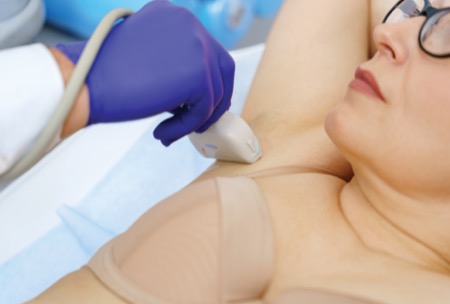The findings of the SOUND trial, which suggest that some patients with early-stage breast cancer and negative axillary ultrasound can forgo sentinel lymph node (SLN) biopsy without compromising oncologic safety or an adjuvant treatment plan (JAMA Oncol 2023;9[11]:1557-1564), appear to be applicable to a real-world population.
These findings may be helpful for U.S. surgeons who welcome the possibility of further de-escalating breast surgery, but question whether the SOUND trial’s findings apply to their own patients, given the European SOUND trial included mainly Italian patients.
“We wanted to examine the generalizability of the SOUND trial on patients at our institution,” said Andreas Giannakou, MD, a breast surgery fellow at Brigham and Women’s Hospital, Massachusetts General Hospital, and Dana-Farber Cancer Institute, in Boston, presenting the study at the 2024 annual meeting of the American Society of Breast Surgeons.
To explore this potential generalizability, they examined nodal disease burden and oncologic outcomes among SOUND-eligible patients treated at their center between 2016 and 2023. Specifically, these were patients with clinical T1N0, hormone receptor–positive, HER2-negative breast cancer retrospectively identified from a prospectively maintained surgical database.
“Those with a negative preoperative [axillary ultrasound] planning breast conservation surgery who had SLN biopsy performed were considered SOUND eligible,” Dr. Giannakou said.
For their primary analysis, they compared clinicopathologic and treatment characteristics of their SOUND-eligible cohort with the SLN biopsy arm of the SOUND trial. The researchers also examined the results of node status and 21-gene recurrence score on chemotherapy recommendations among their postmenopausal SOUND-eligible patients.
Of the 3,972 patients they identified with early-stage, hormone-favorable breast cancer, the final cohort consisted of 312 SOUND-eligible patients who had axillary ultrasound and SLN biopsy. Comparing these patients with the SLN cohort of the SOUND trial, they found clinicopathologic characteristics were overall very similar between the two groups.
“Notably, our cohort included fewer postmenopausal patients. Tumor size, histology and grade were very similar between the two groups, and numerically fewer patients in our cohort received radiation treatment overall, with a very small number receiving partial breast radiation,” Dr. Giannakou said.
Similar to the SOUND trial, 87% of their cohort had a negative SLN biopsy; 9% had a single positive SLN, and less than 3% had two or more positive SLNs.
“Numerically fewer axillary dissections were performed in our cohort, given the fact that we apply [the American College of Surgeons Oncology Group] Z0011 in our institution. However, looking at the total number of positive nodes, the breakdown was very similar between the two groups: 11% of our cohort and 13% of the SOUND trial had one to three positive nodes, and less than 1% of both cohorts had four or more positive nodes,” Dr. Giannakou said.
Similarities with the SOUND trial continued when the researchers looked at adjuvant therapy decisions: The majority of their cohort received hormone therapy with only a small proportion receiving additional chemotherapy.
“At a median follow-up of 26 months, our locoregional recurrence rate was 1.3% (four patients) and our distant metastasis rate was 0.3% (one patient). Obviously, our follow-up was shorter than that of the SOUND trial, yet with similar patient characteristics and disease burden, we expect those outcomes to remain excellent over time,” Dr. Giannakou said.
Lastly, looking at the impact of node status on adjuvant therapy in their postmenopausal SOUND-eligible patients, nodal burden did not appear to affect adjuvant systemic therapy considerations. Decisions regarding chemotherapy treatment appeared to be driven by the recurrence score, indicating that SLN biopsy could be omitted in this patient population without affecting adjuvant chemotherapy recommendations.
“Overall, these findings support careful implementation of omission of surgical staging of the axilla in postmenopausal patients with hormone receptor–positive, HER2-negative breast cancer,” Dr. Giannakou said.
Theresa Schwartz, MD, a breast cancer surgeon with the Henry Ford Cancer Institute, in Detroit, welcomed the Boston group’s corroboration of the SOUND trial findings.
“It definitely adds credence to the SOUND trial showing that ultrasound alone is adequate for nodal staging in many women. If we can get the same information with a noninvasive, comparatively much less expensive test that won’t affect their outcomes or change treatment recommendations, I think everyone who treats breast cancer would be all for it,” said Dr. Schwartz.
Since the SOUND trial was published last year, she has been looking among her own patients for women who would make good candidates for axillary ultrasound alone for nodal staging. “This isn’t a management decision made by surgeons alone. You have to get the whole team on board.”
Dr. Schwartz began by talking with her radiologists to make sure they were comfortable and confident in their ability to assess axillary lymph nodes by ultrasound. “Then I talked with my medical oncologists and radiation oncologists to explain that we will not have definitive pathological evidence of lymph node status in some patients. This trial has demonstrated that we can safely use ultrasound as a surrogate.”
To date, her team has been slowly integrating SOUND trial findings, asking themselves about the appropriateness of certain patients and delving into other questions and concerns outlined in an editorial Dr. Schwartz wrote about implementing SOUND trial data (Ann Surg Oncol 2024;31:2801-2803).
Since the beginning of the year, she has deferred surgical nodal staging on about 30 patients who had a normal axillary ultrasound (as of an interview with her in mid-June). “Axillary ultrasound has once again become an integral part of our breast imaging workup for patients with newly diagnosed breast cancer. We are also monitoring the accuracy of our axillary ultrasounds in patients who ultimately needed to have a SLN biopsy. It is exciting to work towards creating more individualized treatment strategies for our patients with breast cancer.”
—Monica J. Smith

